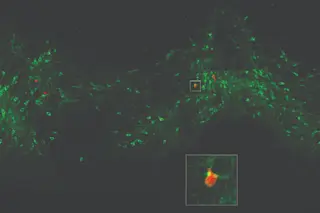This article is a sample from DISCOVER's special issue on the brain.
On the scorecard the play is marked simply as an “error.” But that hardly conveys the magnitude of the blunder committed by Chicago Cubs outfielder Milton Bradley. It is June 12, 2009, in a home game against the Minnesota Twins. Top of the eighth, one out. Bradley catches a routine fly ball. Thinking he has just ended the inning, he tosses the ball into the stands and poses for pictures. Only then does he remember that there are three outs in an inning, not two. The Twins score a run. The Cubbies eventually lose the game.
A rookie mistake? Actually, Bradley was a seasoned pro executing moves he had performed thousands of times. Rather, it is a classic example of a brain fart—an inexplicably stupid error in a straightforward task made by someone with abundant skill and experience. We are all prone to them, although most brain farts are less spectacular (and less humiliating) than Bradley’s—calling your spouse by your ex-spouse’s name, for instance, or zipping straight past the freeway exit that you take every day on your way home from work.
Neuroscientists, a more refined bunch, call these episodes “maladaptive brain activity changes.” But they wonder the same thing we all do: Why does the brain fail to execute on something that should be so easy?
The latest research seems to indicate that brain farts are a unique type of cognitive mistake. Unlike errors caused by lack of information or experience, or by distractions, brain farts are innate. They have a predictable neural pattern that emerges up to 30 seconds before they happen. When you are absorbed in inward-focused thinking such as daydreaming, a collection of brain regions jointly called the default mode network (DMN) starts furiously popping away. Neuroscientists don’t agree on exactly which parts of the brain compose this network, but they now believe it is one of the busiest neurological systems. All that activity may help explain why the adult brain, which represents only about 2 percent of the body’s total weight, consumes up to 20 percent of its energy.
The DMN, while still somewhat mysterious, seems to play many critical roles in overall brain function. It may facilitate the processing of external stimuli by acting as a sort of bushwhacker, carving out communications pathways in the brain. It may foster imagination and creativity. It also appears to be the main culprit in brain farts.
Recent findings begin to explain why we are so prone to dumb goofs. Basically, the brain is a lazy beast; it will take any opportunity to shut down some of its processing systems. “Brains love to pick up regularities, patterns, rules,” says Vince Calhoun, an expert in MRI analysis at the University of New Mexico. “As you generate an expectation, you become less attentive.”
The DMN constantly vies with the attention network for resources, notes Daniel Weissman of the University of Michigan, who specializes in the cognitive neuroscience of attention. In order to execute a consciously directed action, the attention network must inhibit the DMN and the processing of distracting stimuli. But the default mode network is aptly named. Given an opening, the brain naturally reverts to inward thinking rather than attending to external stimulus. Just like boredom itself, the default mode reasserts itself.














